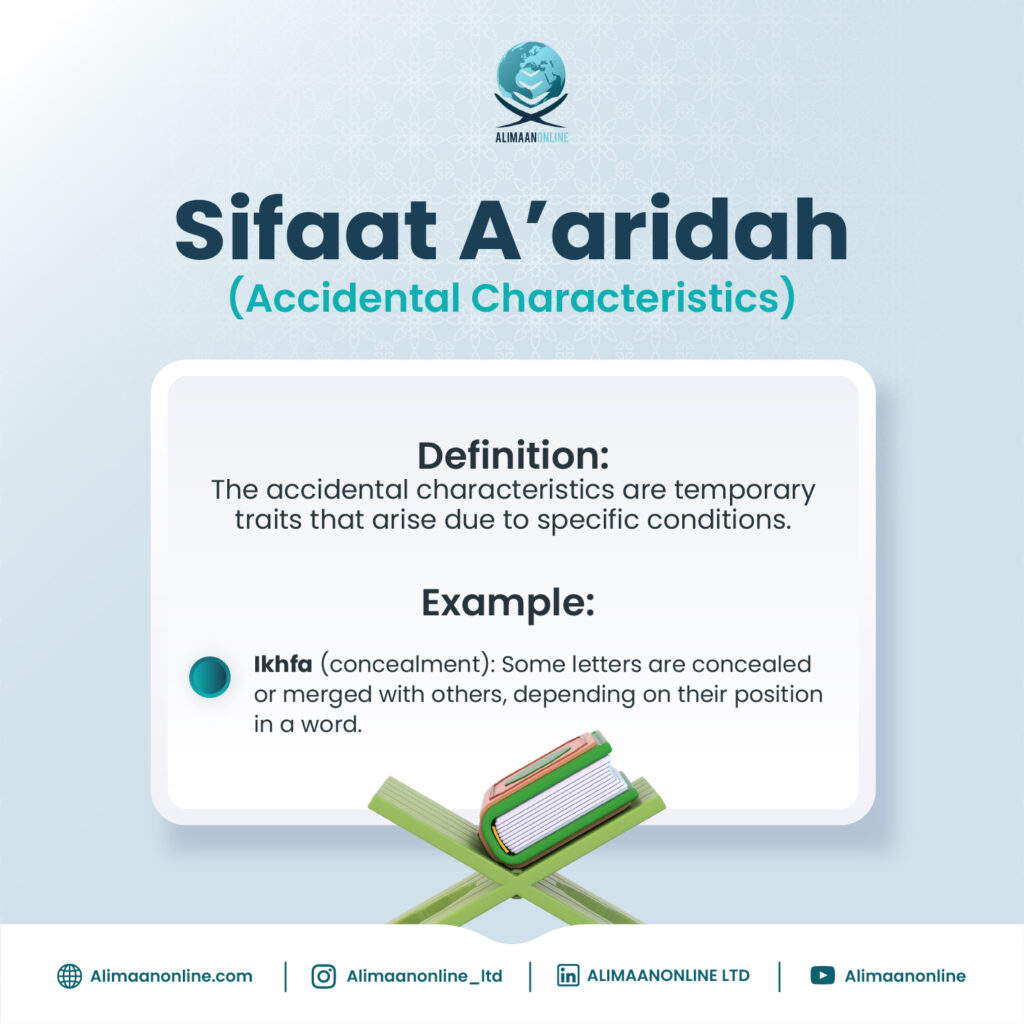In the science of Tajweed, Sifaat A’aridah refers to accidental characteristics that temporarily affect the pronunciation of Arabic letters. These characteristics appear under certain conditions and are not inherent to the letters themselves. Unlike permanent attributes (Sifaat Lazimah), these qualities are present only in specific contexts. There are 11 temporary characteristics in total, each playing a significant role in refining pronunciation and enhancing recitation fluency.
Definition of Sifaat A’aridah
The term Sifaat A’aridah translates to “accidental characteristics,” indicating their temporary nature. These characteristics emerge based on the surrounding phonetic environment, governing articulation, elongation, and clarity. Mastering these traits ensures precision in Quranic recitation, preventing mispronunciations that could alter meanings.
The 11 Temporary Characteristics in Tajweed
1. Izhar (Clear Pronunciation)
Izhar is the clear pronunciation of a letter without nasalization or merging. It occurs when a noon sakinah or tanween is followed by throat letters: Hamzah (ء), Haa (هـ), ‘Ayn (ع), Haa (ح), Ghayn (غ), or Khaa (خ). Mastering Izhar prevents blending, ensuring precise articulation.
2. Idghām (Merging of Letters)
Idghām is the merging of two letters, where the first letter is absorbed into the second. It applies when noon sakinah or tanween meets one of the Idghām letters: Ya (ي), Ra (ر), Meem (م), Lam (ل), Waw (و), or Noon (ن). Idghām improves fluency, making transitions smoother.
3. Iqlāb (Letter Substitution)
Iqlāb involves converting noon sakinah or tanween into Meem (م) when followed by Baa (ب). This transformation occurs with nasalization, requiring the lips to close slightly. Iqlāb ensures natural sound flow and prevents speech disruption.
4. Ikhfāʾ (Concealment)
Ikhfāʾ means partial concealment, where a noon sakinah or tanween blends with the following letter, producing a nasal sound. The degree of concealment depends on the articulation point of the next letter. There are 15 letters of Ikhfāʾ, making this rule essential in maintaining balanced pronunciation.
5. Tafkhīm (Heavy Pronunciation)
Tafkhīm refers to the thickening or heaviness of certain letters, particularly ر (Ra) and letters of isti’laa (خ, ص, ض, غ, ط, ق, ظ). This characteristic enhances the strength and depth of recitation. Applying Tafkhīm correctly differentiates heavy sounds from light ones.
6. Tarqīq (Light Pronunciation)
Tarqīq is the opposite of Tafkhīm. It signifies a lighter articulation applied to letters like ر (Ra) in specific conditions and other letters naturally lacking heaviness. Tarqīq creates balance and prevents excessive weight in recitation.
7. Madd (Elongation of Letters)
Madd is the elongation of vowel sounds, governed by specific letters: Alif (ا), Waw (و), and Yaa (ي) when preceded by a matching vowel. Various types of Madd exist, such as Madd Mutasil, Madd Munfasil, and Madd Arid Lil Sukoon, each influencing recitation length.
8. Qaṣr (Shortening of Vowels)
Qaṣr is the reduction of elongation, opposite to Madd. It ensures controlled vowel duration, preventing excessive prolongation. Mastering Qaṣr is crucial for maintaining a steady recitation flow.
9. Ḥarakāt (Short Vowel Movements)
Ḥarakāt refers to short vowel movements: Fatha (َ), Damma (ُ), and Kasra (ِ). These diacritics determine pronunciation, influencing how letters are articulated in different contexts. Proper Ḥarakāt usage enhances clarity and fluency.
10. Sukūn (Absence of Vowel Sound)
Sukūn represents a letter’s lack of vowel sound, marked by ْ. It signals a stopping point in pronunciation, affecting fluency and articulation. Letters with Sukūn require careful pronunciation to avoid misarticulations.
11. Sakt (Brief Pausing Without Breathing)
Sakt is a brief, controlled pause without taking a breath, applied in specific words of the Quran. It allows for better reflection and recitation rhythm. Understanding Sakt ensures proper breaks, aiding listener comprehension.
12. Ghunna (Nasal Sounding)
Ghunna is a nasal sound applied to Noon (ن) and Meem (م) when they are mushaddad (doubled with shaddah). It is a prominent feature in Tajweed, ensuring smooth recitation by producing a soft nasal resonance.
Difference Between Sifaat A’aridah and Sifaat Lazimah
| Feature | Sifaat A’aridah (Temporary) | Sifaat Lazimah (Permanent) |
|---|---|---|
| Definition | Characteristics that appear due to pronunciation rules and conditions | Inherent attributes of letters that never change |
| Nature | Temporary and situational | Fixed and always present |
| Dependency | Depends on surrounding letters and recitation rules | Independent of surrounding letters |
| Examples | Izhar, Idghām, Iqlāb, Ikhfāʾ, Tafkhīm, Tarqīq, Madd, Qaṣr, Ḥarakāt, Sukūn, Sakt, Ghunna | Hams, Jahr, Shiddah, Tawassut, Rakhawah |
Importance of Mastering Sifaat A’aridah
Correct application of Sifaat A’aridah enhances Quranic recitation, ensuring phonetic precision and fluency. Ignoring these rules can lead to mispronunciations, altering word meanings. By mastering these characteristics, learners improve their Tajweed, gaining confidence in their recitation.
Practical Tips for Learning Sifaat A’aridah
- Listen to Expert Reciters: Observing skilled Qaris helps in identifying and applying temporary characteristics accurately.
- Practice with a Tajweed Instructor: Personalized guidance ensures correct pronunciation and application.
- Use Audio Recordings: Recording oneself and comparing it to expert recitations aids in recognizing mistakes.
- Study with a Mushaf: Reviewing examples in the Quran allows for practical implementation of rules.
Conclusion
Understanding and applying Sifaat A’aridah is essential for perfecting Quranic recitation. These 11 characteristics govern pronunciation, fluency, and articulation, contributing to a melodious and precise recitation. By mastering these temporary traits, learners ensure proper application of Tajweed rules, preserving the beauty of the Quranic text.

